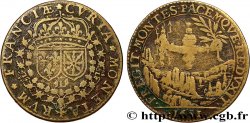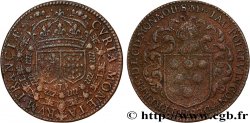E-auction 141-81455 - fjt_299787 - COUR DES MONNAIES DE PARIS Louis XIII 1635
Devi Sign-in ed essere un offerente approvato fare un'offerta, Login per fare offerte. Conti sono soggetti ad approvazione e di approvazione sono raggiunti entro 48 ore. Non aspettare fino al giorno di una vendita si chiude per registrarti.Confermando la tua offerta su questo oggetto ti impegni ad un contratto legalmente vincolante per l'acquisto di questo prodotto e fare clic su «offerta» costituisce accettazione dei termini di utilizzo de e-auctions cgb.fr.
Offerta deve essere collocato in euro gli importi interi vendita only.The si chiuderà al momento sulla descrizione dell'oggetto, eventuali offerte pervenute al sito dopo l'orario di chiusura non verranno eseguite. Volte transmition possono variare e le offerte potrebbero essere respinto se si attende per gli ultimi secondi. Per ulteriori informazioni ckeck le FAQ.
SENZA COSTI PER GLI ACQUIRENTI.
SENZA COSTI PER GLI ACQUIRENTI.
| Valutazione : | 120 € |
| Prezzo : | 49 € |
| Offerta maxima : | 50 € |
| Data di fine vendita : | 28 dicembre 2015 19:19:00 |
| partecipanti : | 9 partecipanti |
Tipo : Louis XIII
Data: 1635
Nome della officina / città: Nuremberg
Metallo : ottone
Diametro : 25,5 mm
Asse di coniazione : 11 h.
Peso : 4,12 g.
Orlo : lisse
Grado di rarità : R2
N° nelle opere di riferimento :
Pedigree :
Ce jeton provient de la collection Pierre-Yves Lathoumétie
Diritto
Titolatura diritto : CVRIA. MONETARVM. FRANCIAE.
Descrittivo diritto : Écus de France et de Navarre couronnés et entourés des deux colliers des ordres du roi.
Rovescio
Titolatura rovescio : CAELVM. LILIO. LILIVMQVE. TERRIS ; À L'EXERGUE : 1635.
Descrittivo rovescio : Un lis surmonté d'une couronne, accosté de six autres couronnes.
Commento
Jeton particulièrement énigmatique que nous attribuons à Nuremberg bien qu’il ne soit pas signé et que son style soit excellent. En effet, il est d’un diamètre légèrement réduit, d’un poids léger et surtout d’un axe irrégulier. Si ce n’est Nuremberg, c’est à coup sur un atelier non officiel.
Notons par ailleurs que le revers est copié sur un coin de 1634 (Voir Feuardent 12192 où les couronnes sont bien particulières et différentes de celles du jeton de la Cour des Monnaies de 1609) et que les ateliers de Nuremberg ont souvent plagié des types de la Cour des Monnaies, voir par exemple les jetons d’André Hac.
Bien entendu, une autre raison de penser à un jeton non officiel est qu’il existe, pour l’année 1635, un jeton officiel.
A particularly enigmatic token that we attribute to Nuremberg, although it is not signed and its style is excellent. Indeed, it is slightly reduced in diameter, light in weight, and above all, has an irregular axis. If it is not Nuremberg, it is certainly an unofficial mint. Note also that the reverse is copied from a die from 1634 (See Feuardent 12192 where the crowns are very particular and different from those of the token of the Court of Mints of 1609) and that the Nuremberg mints often plagiarized types from the Court of Mints, see for example the tokens of André Hac. Of course, another reason to think of an unofficial token is that there exists, for the year 1635, an official token
Notons par ailleurs que le revers est copié sur un coin de 1634 (Voir Feuardent 12192 où les couronnes sont bien particulières et différentes de celles du jeton de la Cour des Monnaies de 1609) et que les ateliers de Nuremberg ont souvent plagié des types de la Cour des Monnaies, voir par exemple les jetons d’André Hac.
Bien entendu, une autre raison de penser à un jeton non officiel est qu’il existe, pour l’année 1635, un jeton officiel.
A particularly enigmatic token that we attribute to Nuremberg, although it is not signed and its style is excellent. Indeed, it is slightly reduced in diameter, light in weight, and above all, has an irregular axis. If it is not Nuremberg, it is certainly an unofficial mint. Note also that the reverse is copied from a die from 1634 (See Feuardent 12192 where the crowns are very particular and different from those of the token of the Court of Mints of 1609) and that the Nuremberg mints often plagiarized types from the Court of Mints, see for example the tokens of André Hac. Of course, another reason to think of an unofficial token is that there exists, for the year 1635, an official token








 Segnalare un errore
Segnalare un errore Stampate la pagina
Stampate la pagina Condividi mia selezione
Condividi mia selezione Fai una domanda
Fai una domanda Consegnare / vendere
Consegnare / vendere
 Descrittivo
Descrittivo









